The Agreement of the Central People's Government and the Local Government of Tibet on Measures for the Peaceful Liberation of Tibet (the 17-Article Agreement) signed in 1951 explicitly stipulated that in matters relating to reforms in Tibet, there would be no coercion on the part of the Central Government, and reform should be carried out by the Tibetan local government of its own accord. In 1956, the Central Government put forth the principle to the effect that the reform would not be carried out in six or longer years in Tibet. The upper-strata clique in Tibet, however, stood in strong opposition to the reform and tried hard to preserve forever the feudal serfdom featuring temporal and religious administration. Under the instigation of the anti-China forces in the West, they staged an armed rebellion in March 1959. The Central Government, in response to the strong demand and support of people of various ethnic groups in Tibet, suppressed the armed rebellion, and then conducted the Democratic Reform. During the Democratic Reform, the feudal serfdom featuring temporal and religious administration was abolished, making it possible for the million slaves and serfs in Tibet, who accounted for over 95 percent of the Tibetan population, to win emancipation, and for the first time in history become masters of the country and society, masters of land and other means of production, and masters of their own fate. Tibet entered into a new era of social development and the development of human rights cause. In 1965, the Tibet Autonomous Region was founded, marking the establishment of the ethnic autonomous regional system in Tibet.
Photo 3-1
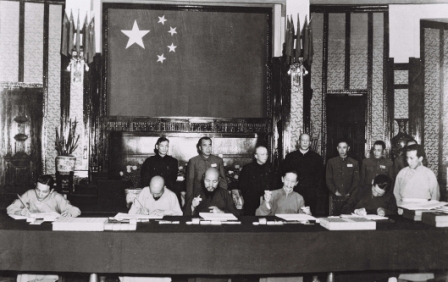
On May 23, 1951, the Agreement of the Central Government and the Local Government of Tibet on Measures for the Peaceful Liberation of Tibet (i.e., the 17-Article Agreement) was signed in Beijing. Picture shows delegatges of the former Tibetan local government delegation—Ngapoi Ngawang Jigmei, Kemai Soinam Wangdui, Tubdain Daindar, Tubdain Legmoin and Sampo Dainzin Toinzhub--and representatives of the Central Government delegation—Li Weihan, Zhang Jingwu, Zhang Guohua and Sun Zhiyuan—were signing the agreement. Vice-President Zhu De, Vice-President Li Jisheng and Vice-Premier Chen Yi attended the signing ceremony.
The People’s Republic of China was founded in 1949. Given the historical conditions and the reality in Tibet, the Central Government decided to adopt a policy for the peaceful liberation of Tibet. The 14th Dalai Lama sent people to New Delhi on January 27, 1951, to ask the Chinese ambassador there to bring his letter to the Central Government, which expressed his willingness to hold peace talks with the Central Government. On February 28, the 14th Dalai Lama sent a group of five Tibetan delegates headed by Ngapoi Ngawang Jigmei to Beijing for the purpose. On May 23, 1951, representatives from the Central Government and the local government of Tibet signed the 17-Article Agreement.
The agreement for the peaceful liberation of Tibet enjoyed the approval and support of the people from every ethnic groups in Tibet. A conference of all ecclesiastic and secular officials and representatives of the three major monasteries ((the Sera, Gandain and Zhaibung Monasteries) in Lhasa was called by the Tibetan local government between September 26 and 29, 1951 to specifically discuss the agreement. A report to the 14th Dalai Lama was approved at the end of the conference. It stated, "The 17-Article Agreement that has been signed is of great and unrivaled benefit to the grand cause of the Dalai and to Buddhism, politics, economy and other aspects of life in Tibet. Naturally it should be implemented." The 14th Dalai Lama sent a telegram to Chairman Mao Zedong on October 24, 1951, in which he wrote, "On the basis of friendship, delegates of the two sides signed on May 23, 1951 the Agreement on Measures for the Peaceful Liberation of Tibet. The Tibetan local government as well as ecclesiastic and secular people unanimously support this agreement, and under the leadership of Chairman Mao and the Central Government, will actively assist the PLA troops entering Tibet in consolidating national defense, ousting imperialist influences from Tibet and safeguarding the unification of the territory and the sovereignty of the motherland." The 10th Panchen Erdeni and his Kampus Assembly also issued a statement, pointing out that the agreement "conforms fully to the interests of all ethnic groups of China, particularly those of the Tibetans."
Photo 3-2

Picture shows Chairman Mao Zedong (third left), Vice-President Liu Shaoqi (fifth left) and Premier Zhou Enlai (first left) celebrating the Tibetan New Year in Beijing together with the 14th Dalai Lama and the 10th Panchen Erdeni (second left).
After the peaceful liberation of Tibet, the Central Government and upper-class patriotic forces of Tibet did a great deal of work to implement the 17-Article Agreement. In 1954 the 14th Dalai Lama and the 10th Panchen Erdeni came to Beijing to attend the First National People's Congress (NPC) of the People's Republic of China. In his speech at the congress, the 14th Dalai Lama fully confirmed the achievements in the implementation of the 17-Article Agreement over the preceding three years, and expressed his warm support for the principles and provisions concerning national regional autonomy in the draft of New China's first Constitution, which was under discussion at the congress. Talking about religious issues, the 14th Dalai Lama said that the Tibetan people had deeply held religious beliefs, and they were formerly made anxious by fallacious rumors spread by some people that "the Communist Party and the people's government will extinguish religion." However, he added, "the rumors that aim to sow discord have all been exploded and the Tibetan people know from our own experience that we have freedom of religious belief." He expressed the desire to gradually build Tibet into a land of prosperity and happiness under the leadership of the Central Government and with the help of people of other ethnic groups. On September 20, the 14th Dalai Lama, the 10th Panchen Erdeni and the other Tibetan deputies, along with the deputies from other ethnic groups, approved the Constitution of the People's Republic of China by casting their ballots. At the session, the 14th Dalai Lama was elected a vice-chairman of the NPC Standing Committee, and the 10th Panchen Erdeni a member of the NPC Standing Committee. In their capacity as state leaders, they exercised their rights of participating in the management of State affairs in accordance with the Constitution.
Photo 3-3
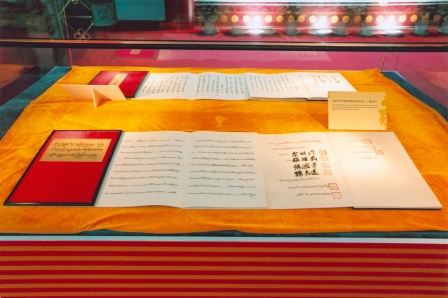
Picture shows the Tibetan text of the 17-Article Agreement.
The Central Government and the local government of Tibet signed in 1951 the 17-Article Agreement on measures for the peaceful liberation of Tibet, which is a legal document of the Central Government on the solution of the Tibetan issue and was a new page of the history.
It was stipulated in the agreement that the Tibetan people should unite and drive out imperialist aggressive forces from Tibet; the local government of Tibet should actively assist the PLA in entering Tibet and consolidating national defense; regional ethnic autonomy would be instituted in Tibet; the Central Government would not alter the existing political system in Tibet or the established status, functions and powers of the 14th Dalai Lama and the 10th Panchen Erdeni, and officials of various ranks would continue to hold office as usual; the policy of freedom of religious belief would be upheld and the religious beliefs, customs and habits of the Tibetan people would be respected; the spoken and written language and school education of the Tibetan ethnic group would be developed step by step, along with agriculture, livestock raising, industry and commerce in order to improve the people's livelihood; and foreign affairs involving the Tibetan region would be under the unified management of the Central Government. The agreement also explicitly stipulated that in matters relating to reforms in Tibet, there would be no coercion on the part of the central authorities, and reform would be carried out by the Tibetan local government of its own accord.
Photo 3-4

14th Dalai Lama, requesting earlier start of the reform. Bearing fingerprints of the 65 peasants, it reads in part, “We are all peasants who do farming. We are more anxious than any others in seeing the earlier beginning of the reform.” Picture shows the joint letter.
Photo 3-5

Picture shows the office building of the CPC Tibet Work Committee in Lhasa.
After the peaceful liberation of Tibet in 1951, many enlightened people of the upper and middle classes also realized that if the feudal serfdom was not reformed, the Tibetan people would never attain prosperity. In light of Tibetan history and the region's special situation, the Central Government adopted a very prudent attitude toward the reform of the social system in Tibet. The 17-Article Agreement stipulated that the Central Government would not use coercion to implement such reform and that it was to be carried out by the Tibetan local government on its own. However, some members of the Tibetan ruling class were hostile to reform and wanted to preserve the serfdom forever so as to maintain their own vested interests. With the support of the anti-China forces in the West, they deliberately violated and sabotaged the 17-Article Agreement and intensified their efforts to split the motherland.
Between March and April 1952, Sicab Lukangwa and Lobsang Zhaxi of the Tibetan local government gave secret support to the illicit organization "the people's conference" to oppose the 17-Article Agreement and create disturbance in Lhasa, demanding that the PLA "pull out of Tibet." In 1955, Galoin Surkang Wangqen Geleg of the Tibetan local government and others secretly plotted an armed rebellion in the Tibetan-inhabited area of Xikang Province. Rebellion broke out in that area in 1956 and the rebels besieged the local government institutions and massacred hundreds of government staff as well as common people. In May 1957, with the support of Galoins Neuxar Tubdain Tarba and Xainga Gyurme Doje, a rebel organization named "four rivers and six ranges" and later the rebel armed forces named "religion guards" were founded. They raised the slogan of "Tibetan Independence" and "opposition to reform" and further intensified their rebellious activities. The armed rebels harassed Qamdo, Dengqen, Heihe and Shannan. They killed cadres, disrupted communication lines, and attacked institutions and army troops stationed there by the central authorities. They looted, cruelly persecuted people and raped women.
On March 31, 1952, close to 1,000 monks from the Zhaibung and Sera Monasteries moved into the downtown area of Lhasa. They made trouble trying to stir up events and besieged the sites of the office buildings of the Central Government delegates and the CPC Tibet Work Committee.
Photo 3-6

In his book The United States, Tibet and China, American Norman C. Hall revealed that in 1957 the CIA culled six young men from among Tibetans residing abroad and sent them to Guam of the United States to receive training in map-reading, radio transmission, shooting and parachuting. Subsequently, the United States trained 170 "Kamba guerrillas" in batches in Hale Camp, Colorado. The trained "Kamba guerrillas" were air-dropped or sneaked into Tibet to "launch an effective resistance movement" to "oppose the Chinese occupation." An article entitled The CIA Tibetan Conspiracy in the Hong Kong-based Far Eastern Economic Review disclosed in its September 5 issue of 1975 that in May 1958, two agents trained by the Americans in the first batch brought a transceiver to the headquarters set up by the rebel leader Anzhugcang Goinbo Zhaxi in Shannan to make contact with the CIA. Before long, the United States air-dropped arms and ammunition, including 20 sub-machine guns, two mortars, 100 rifles, 600 hand-grenades, 600 artillery shells and close to 40,000 bullets, to the rebels in the plateau called Chigu Lama Thang. During the same period, the United States clandestinely shipped large amounts of arms and ammunition overland to the rebels entrenched in the Shannan area.
With the collusion of the Tibetan serf-owners bent on retaining serfdom and the anti-China forces in the West, the rebellious activities soon became rampant. The climax was the elaborately planned armed rebellion in Lhasa on March 10, 1959.
On February 7, 1959, the 14th Dalai Lama took the initiative and said to Deng Shaodong, deputy commander of the PLA Tibet Military Area Command, and other officers, "I was told that after its return from studies in the hinterland, the Song and Dance Ensemble under the Tibet Military Area Command has a very good repertoire. I would like to see its show. Please arrange it for me." Deng and the other officers expressed immediate readiness and asked the 14th Dalai Lama to fix the time and place for performance. They also conveyed the 14th Dalai Lama's wish to Surkang and other Galoins of the Tibetan local government and Paglha Tubdain Weidain, adjutant general of the 14th Dalai Lama. On March 8, the 14th Dalai Lama said he would go to the performance in the Tibet Military Area Command Auditorium at 3 pm on March 10. The Tibet Military Area Command carefully prepared for the occasion. But on the evening of March 9, the Miboin (mayor) of Lhasa provoked citizens by saying: tomorrow the 14th Dalai Lama will go to the Military Area Command for a banquet and a performance; the Hans have prepared a plane to kidnap the 14th Dalai Lama to Beijing; every household should send people to the Norbu Lingka, the residence of the 14th Dalai Lama, to petition him not to attend the performance in the Military Area Command. The next morning, the rebels coerced more than 2,000 people to mass at the Norbu Lingka, spreading the rumor that "the Military Area Command is planning to poison the 14th Dalai Lama" and shouting slogans such as "Tibetan Independence" and "Away with the Hans." The rebels hit and wounded Sampo Cewang Rinzin, a former Galoin of the Tibetan local government and then a deputy commander of the Tibet Military Area Command. They stoned to death Kainqoin Pagbalha Soinam Gyamco, a progressive patriot and member of the Preparatory Committee for the Founding of the Tibet Autonomous Region. His body was tied to the tail of a horse and dragged through downtown as a warning. Subsequently, the rebel leaders convened the so-called "people's congress" and "people's conference of the independent state of Tibet," intensifying their efforts to organize and expand armed rebellion. They brazenly tore up the 17-Article Agreement and declared "the independence of Tibet," launching a full-scale armed rebellion against the motherland.
Picture shows a notice of the "people's conference of the independent state of Tibet."
Photo 3-7

In March 1959, some reactionary forces on the upper-echelon of the ruling class in Tibet launched an armed rebellion in an all-round way. In the name of the "people's conference of the independent state of Tibet", they sent two confidential cables to Xagaba Ziboin, a separatist residing overseas, on March 16 and 17. The cables declared the establishment of the “independent state of Tibet” on the first day of the second Tibetan month (March 10), and requested it be made public for foreign and international organizations to “send delegates to investigate and inspect Tibet immediately and to manage to find support.” On the evening of the 17th, the 14th Dalai Lama and some of the rebels fled Lhasa to India via Shannan.
On the evening of the 19th, the rebels launched an all-round attack at the sites of the PLA troops stationed in Lhasa and the Central Government Lhasa office and other institutions. Finally, the rebellion broke out in an all-round way and Lhasa was the central point of the rebellion.
On June 20, 1959, the 14th Dalai Lama, who was already in India, held his first press conference. He refuted the 17-Article Agreement and declared “PLA invasion of Tibet.” In order to set up his “independent state of Tibet,” the Dalai clique worked hard to organize the “Tibetan government in exile”, the private secretariat of the 14th Dalai Lama, “the religion-protecting army of the four rivers and six ranges,” “special border forces” and other armed forces with a view to restoring the feudal serfdom in Tibet.
Picture shows the cable of the "people's conference of the independent state of Tibet" to Xagaba Ziboin, which declared the establishment of the “independent state of Tibet” on the first day of the second Tibetan month (March 10), and requested it be made public for foreign and international organizations to “send delegates to investigate and inspect Tibet immediately and to manage to find support.”
Photo 3-8

Picture shows the photocopy of the letters the 14th Dalai Lama wrote to Central Government acting representative Tan Guansan on March 11, 12 and 16, 1959.
In 1959 the rebel leaders convened the so-called "people's congress" and "people's conference of the independent state of Tibet," intensifying their efforts to organize and expand armed rebellion. They brazenly tore up the 17-Article Agreement and declared "the independence of Tibet," launching a full-scale armed rebellion against the motherland.
Although the Norbu Lingka was controlled by the rebels and it was hard to make contact with the 14th Dalai Lama, acting representative of the Central Government Tan Guansan managed to send three letters to the 14th Dalai Lama on March 10, 11 and 15 through patriots. In them, Tan expressed his understanding of the 14th Dalai Lama's situation as well as his concern for the latter's safety. He pointed out that the rebels were making reckless military provocations and demanded that the Tibetan local government immediately work to stop them. The 14th Dalai Lama penned three letters in reply to Tan on March 11, 12 and 16. In his letters, the 14th Dalai Lama wrote, "Reactionary, evil elements are carrying out activities endangering me under the pretext of ensuring my safety. I am taking measures to calm things down." "The unlawful activities of the reactionary clique cause me endless worry and sorrow.... As to the incidents of yesterday and the day before, which were brought about under the pretext of ensuring my safety and have seriously estranged relations between the Central Government and the local government, I am making every possible effort to deal with them." In the letter of March 16, he said that he had "educated" and "severely criticized" officials of the Tibetan local government. He also expressed the desire to still go to the Military Area Command a few days later. All three letters of the 14th Dalai Lama have been photographed by reporters of the Xinhua News Agency and published, and are still well preserved.
However, on the evening of March 17, Galoins Surkang, Neuxar and Xaisur and other rebel leaders held the 14th Dalai Lama under duress and carried him away from Lhasa to Shannan, the "base" of the armed rebel forces. When the armed rebellion failed, they fled to India.
Photo 3-9
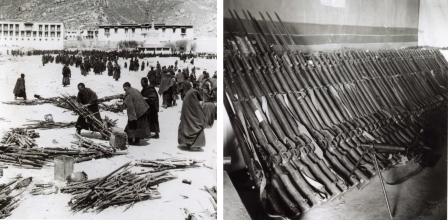
Captured arms and ammunitions used by the rebels from the three major monasteries (the Sera, Gandain and Zhaibung Monasteries) in Lhasa.
Photo 3-10

Picture shows the US-made transmitter-receivers captured by the PLA during the suppression of the armed rebellion.
After the peaceful liberation of Tibet, the United States did its best to go on supporting Tibetan separatists. At that time, the CIA chief vowed to provide Tibetan rebels with aid and support.
In the fall of 1958, the CIA airlifted four rebels who had received training in the United States to Litang area in west Sichuan Province. One of the four was killed while landing. Three others found the rebel supporters but two of them were also killed by the PLA. Wangdui Gyamco, chief of the four, was the only survivor. He entered Tibet but lost his transmitter-receiver. In July 1958 and February 1959, the CIA airdropped 403 rifles, 20 sub-machine guns, 60 crates of hand grenades and bags of Indian rupees in circulation. The rebles locked in a bloody fight for these materials.
All the evidences support the conclusion that the CIA had directly got involved in the 1959 armed rebellion in Tibet.
Photo 3-11

In August 1998, the US Department of State released some archives on CIA’s support for “Tibetan independence” during the cold war period. Picture shows a letter from the anti-China forces to Tibetan separatists.
Photo 3-12

March 28 Decree of the State Council.
On March 28, 1959, Premier Zhou Enlai ordered the PLA Tibet Military Area Command to suppress the armed rebellion. The local government of Tibet was disorganized and the Preparatory Committee for the Founding of the Tibet Autonomous Region was reorganized to wield the power in the place of the former local government of Tibet. This put an end to the feudal serfdom featuring temporal and religious administration in Tibet. The Preparatory Committee also exercised leadership over the Democratic Reform in 1959.
The Central Government retained the official post of the 14th Dalai Lama as a Vice-Chairman of the NPC Standing Committee until December 1964.
Photo 3-13
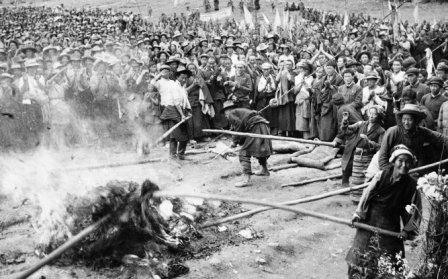
Picture shows emancipated serfs from Dagze County throwing title deeds and debt contracts into fire.
In late March 1959, the Democratic Reform began in Tibet. The first step of the Reform was the movement to oppose rebellion, Ula corvee and personal attachment, and reduce rent and interest. In the rural areas, the peasants were allowed to own harvests from land owners who were involved in the rebellion which they tilled. With regard to the land owners who were not involved in the rebellion, the land owners kept 20 percent of harvests while those who rented and tilled the land kept 80 percent of harvests. At the same time, efforts were made to emancipate household slaves and abolish personal attachment. In the pastoral areas, livestocks of flockmasters who were involved in the armed rebellion were looked after by herders who were allowed to own income from this. Livestocks of flockmasters who were not involved in the rebellion continued to be owned by the flockmasters. But the exploitation was reduced for those who herded these animals to increase income. As the second step of the Democratic Reform, efforts were made to confiscate the means of production of the lords who were involved in the armed rebellion, and distribute them among the poverty-stricken peasants and herders. For the lords who were not involved in the armed rebellion, the State purchased their means of production for free distribution among the poverty-stricken peasants and peasants; the lords were also given some means of production.
These policies and measures received warm welcome from people from all walks of life, especially the poor and the slaves and serfs. Many upper-class personages also expressed understanding and wish for cooperation. This guaranteed the smooth progress of the Demcoratic Reform, which ended successfully in 1961.
The Demcratic Reform in Tibet abolished the feudal serfdom and made it possible for the slaves and serfs to gain, for the first time in history, land and other means of production, and personal freedom.
Photo 3-14

On August 10, 1959, serfs from the Gandain Monastery manor burned up Ula corvee contracts, usury contracts and indentures by which they were sold. From then on, the monasteries enjoyed no feudal priviledges.
Photo 3-15
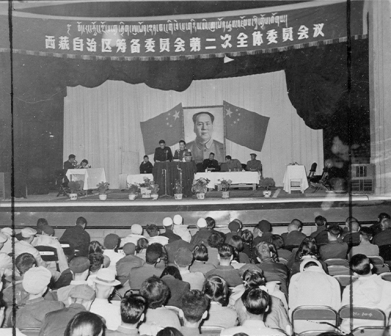
From June 28 to July 17, 1959, the Preparatory Committee for the Founding of the Tibet Autonomous Region held its second session which adopted the Resolution on the Implementation of the Democratic Reform in Whole Tibet. Picture shows the session hall.
Photo 3-16
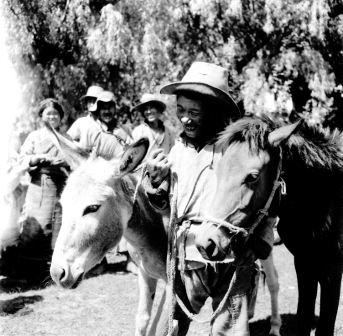
Galsang who was groom for the butler of serf-owner Soikang for 30 years was happy to be given a mare and a donkey during the Democratic Reform.
Photo 3-17a

Galsang Chima, 76, from Caigongtang Township, East District of Lhasa, was happy to be given the land deed.
Photo 3-17b
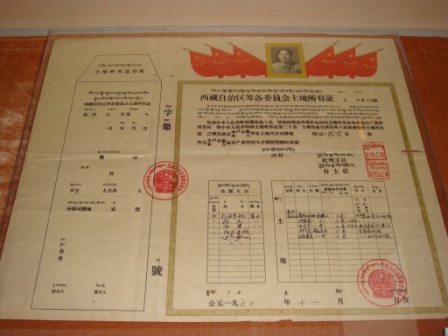
Land deeds issued then.
Photo 3-18
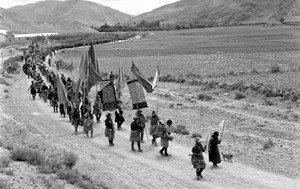
Peasants in Nedong County, Shannan, supported the Democratic Reform by holding a demonstration to show opposition to armed rebellion, Ula corvee and enslavement, and support for rend and interest reduction.
Photo 3-19
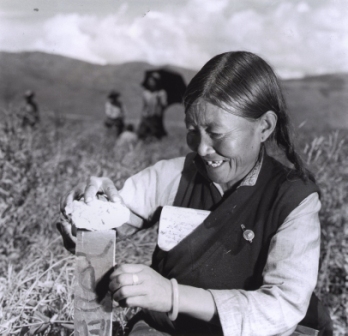
Lobsang Zholma,vice-chairman of the Lhagyili Township Peasants’ Association of Lhagyili County nailing markers on the land she was allotted.
Photo 3-20

During the Democratic Reform, emancipated serfs were given land and other means of production for the first time in history. Wochin Cering, a lifelong nangzan, was given land to till. Holding earth taken from his land, he said to himself, “Oh, dear land, you are finally mine now.”
Photo 3-21

Picture shows the Democratic Reform office worker issuing pay to Namdun Gongga Wangcho for the State purchase of his means of production.
During the Democratic Reform, the State purchased the means of production from manorial lords who were not involved in the armed rebellion for free distribution among poverty-stricken peasants and herders; and the land owners and flockmasters were also given means of production. The Democratic Reform office in charge of the work handled procedures for 23 major manorial lords whose means of production were purchased by the State. They include Namdun Gongga Wangcho, Silun official with the former local government of Tibet and a patriot.
Photo 3-22

Picture shows the mutual-aid team formed by 11 nangzan slaves in Gyipa Township.
Serfs in Gyipa Township were given land to till during the Democratic Reform in 1958. As they lacked experience in farming and as they didn’t have adequate farm tools, however, they failed to enjoy good harvests. In 1961, the township government decided that the local emancipated serfs volunteer to form mutual-aid teams. One of these is the mutual-aid team formed by 11 nangzan serfs. Headed by Cering Lhamo (first left), the team succeeded in increasing the number of farm cattle from three in 1961 to 14 in 1964. And the number of other animals the team owned increased from 93 to 234 during the period. In 1961, six households of the team were in short of food grains. In 1964, however, all of them had surplus food grains.
Photo 3-23
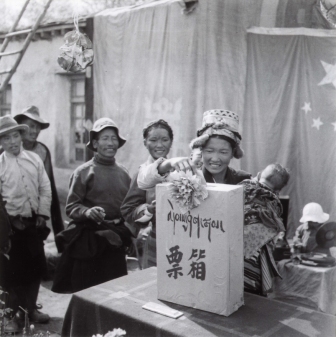
Picture shows emancipated serfs voting.
In 1961, public election of governments at various levels in the region was held in Tibet for the first time in history. Exercising the right to vote and the right to stand for election, right given them by the PRC Constitution and the laws, emancipated serfs and slaves take part in regional and national elections, and handle regional and national affairs through delegates they elected.
Photo 3-24

The Second Session of the Ninth People’s Congress of the Tibet Autonomous Region adopted a resolution on January 19, 2009 that March 28, the day in 1959 the Central Government ordered the disorganization of the local government of old Tibet, be the “Serf Emancipation Day” of Tibet. This is meant to mark the 50th anniversary of the Democratic Reform.

























